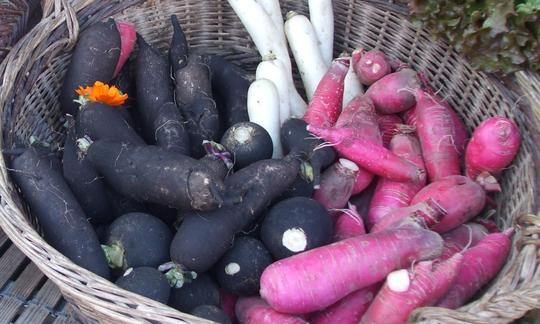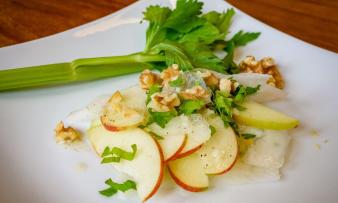Table of contents
Garden radish ( Raphanus sativus), also called radish, In Europe it is mostly used raw (preferably organic) and in Asia it is pickled or steamed.
Use in the kitchen
Garden radish ( Raphanus sativus) is a tuber or root vegetable that is grown and consumed all over the world. 1 The species Raphanus sativus is divided into three to four groups (at the level of subspecies or varieties): oil radish ( Raphanus sativus var. oleiformis), rat-tail radish ( Raphanus sativus convar. caudatus or var. mougri) and the radish group with radishes ( Raphanus sativus var. sativus) and radishes such as black winter radish, white beer radish, daikon (also called winter radish, Japanese radish, Chinese radish). The focus of this article is on the radishes of the radish group (excluding radishes). You can find more information about radishes in the associated article. By the way: the cultivated form of the garden radish, Daikon or winter radish ( Raphanus sativus L. var. sativus), is a milder tasting giant radish from East Asia.
The radish root is spherical to spindle-shaped and varies in size and length. The varieties also differ in the color of the skin (white, red, yellow, green, black). The flesh is usually white. 1 The spicy, hot taste is due to the mustard oils it contains. The spiciness can be reduced by sprinkling the radish with salt, allowing it to soak for about 5 minutes and then dabbing it off. The root also loses its spiciness when cooked.
With the exception of black winter radish, garden radishes do not need to be peeled. Rinsing thoroughly and patting dry is sufficient. Depending on the recipe, you can then cut the radish into slices or sticks, slice it or grate it.
Can you eat radish raw? Raw garden radish is edible. In Germany and Switzerland it is traditionally eaten raw. In Bavaria it is known as radish (radish vegetable), which is often served in beer gardens with beer and pretzels. It can be eaten plain or sliced and seasoned with a little salt as a spread on bread. Thinly sliced or grated radish also enriches all kinds of salads as a raw food. Recommended garden radish recipes are apple and radish salads with walnuts (e.g. raw vegan radish salad with apple, celery leaves and lime dressing), cucumber and radish salads or root salads with various root vegetables such as carrots, beetroot and parsnips. Cut into wide noodles with a spiral cutter, radish is also a healthy and raw pasta substitute.
However, the root can also be eaten boiled, steamed or fried. Steamed radish or radish slices baked in the oven taste good as a side dish. Radish is also excellent in potato pancakes, vegan flans and soups (e.g. with potatoes and apple juice). It can also be used to make fine, crispy radish chips.
In Asia, radish is usually eaten pickled in vinegar or fermented with other ingredients. 2 It is a traditional ingredient in kimchi (e.g. with Chinese cabbage, carrots and spring onions). It is also used as a filling for vegetarian and vegan spring rolls and dim sum. Radish fried with curry paste or Asian vegetable stir-fries with radish (and e.g. carrots, red bell peppers and leeks in soy sauce, ginger, garlic and lemongrass) served with jasmine rice or basmati rice are also tasty dishes.
In the Middle East, people prefer to drink the juice of radishes because it is said to have certain health benefits. 1 Radish can also be processed with fruits and other vegetables to make healthy smoothies.
Tip: Beautiful and edible garnishes made from radish, such as a radish rose, add value to any meal. To do this, slice a thin slice off a peeled radish and roll it up into a snail shape. Wrap the bud around three to five more slices and secure the whole thing with a toothpick.
Vegan recipe for radish salad with radishes and fennel
Ingredients (for 2 people): 1 garden radish (raw, organic), 1 fennel, 1 bunch of radishes, 1 bunch of chives, 2 tbsp rapeseed oil, 2 tbsp lemon juice, 1 tbsp apple cider vinegar, 1 tsp mustard (sweet), some salt andpepper.
Preparation: Wash the vegetables. Cut the garden radish into thin slices or slice it. Cut the fennel into thin strips and the radishes into thin slices. Put the vegetables in a bowl and mix them together. Rinse the chives, shake dry, cut into small rings and put them in the bowl. For the dressing, mix the oil, lemon juice, apple cider vinegar and mustard and season with a little salt and pepper. Pour the dressing over the vegan raw food salad, stir well and serve.
Vegan recipes with garden radish (raw) can be found under the note: " Recipes that have the most of this ingredient ".
| Not only vegans or vegetarians should read this: Vegans often eat unhealthily. Avoidable nutritional mistakes. |
Shopping - Storage
Many supermarkets (e.g. Coop, Migros, Spar, Lidl, Rewe, Edeka, Billa) offer raw radishes all year round. Other supermarkets (e.g. Denner, Volg, Aldi, Hofer) only offer radishes during special weeks. Organic radishes can also be found in organic supermarkets such as Denn's Biomarkt and Alnatura. At weekly markets you can buy particularly fresh and local garden radishes. The tuber vegetable is in season from April to December. In November and December, the radishes in the store mainly come from the warehouse. 3
You can recognize fresh specimens by their undamaged, smooth skin and firm consistency. Any remaining foliage should also appear lush green and not wilted.
The availability of garden radish (raw) varies depending on the size of the store, catchment area, etc. You can find our recorded food prices for the DA-CH countries above under the ingredient image - and by clicking you can see their development at various suppliers.
Storage tips
Fresh spring or summer radishes can be stored in the vegetable compartment of the refrigerator for a week if wrapped in a damp cloth. Autumn and winter radishes can be stored in the cellar for up to six months. Temperatures around 0 °C and high humidity are optimal storage conditions. In both cases, any existing leaves should be removed for storage. 4
Ingredients - Nutritional values - Calories
What is the nutritional value of garden radish? Raw garden radish is very low in calories and fat, with 14 kcal and 0.1 g fat per 100 g. Carbohydrates are also present in small amounts, at 2.6 g/100g. Proteins are present at 1.1 g/100g. 5 The following are three important radish nutrients that occur in significant quantities.
100 g of raw radish contains 29 mg of vitamin C (ascorbic acid), which is 36% of the daily requirement. This content is similar to that of turnips (25 mg/100g) and savoy cabbage (31 mg/100g). Yellow bell peppers contain significantly more vitamin C at 184 mg/100g. 5
Does radish contain potassium? The potassium content is 280 mg/100g (14% of the daily requirement). Cauliflower (299 mg/100g) and celeriac (300 mg/100g) have a similar content. Fennel seeds, of which only small amounts are used, contain a particularly high amount of potassium at 1694 mg/100g. 5
Raw radish also contains 14 µg folate per 100 g (7% of the daily requirement). Jerusalem artichokes (13 µg/100g) and turnips (15 µg/100g) contain a similar amount of folate. Raw spinach contains 194 µg/100g, which is about 14 times the amount of the vitamin. 5
Radish also contains significant amounts of bioactive ingredients, so-called secondary plant substances. These include flavonoids, polyphenols, terpenes, glucosinolates and anthocyanins. The leaves and sprouts contain particularly large amounts of these. 21
The complete ingredients of garden radish (raw), the coverage of the daily requirement and comparison values with other ingredients can be found in our nutrient tables. In the article Nutrients explained you will get a detailed insight into the topic.
Effects on health
How healthy is radish? Radish contains bioactive compounds that have recently been recognized as potentially beneficial to human health. The most important compounds are glucosinolates and isothiocyanates. 1 What effect does radish have on the body? Various studies report on the anti-inflammatory, antimicrobial, antioxidant, antimutagenic and anti-cancer properties of radish. 1, 6,7 Radish also appears to have antidiabetic effects and may have an effect on reducing hyperlipidemia. 1, 7
Black radish has shown hypocholesterolemic, antilithiasis and antioxidant properties in various biological models. These effects may promote the formation of Prevent cholesterol gallstones, an increasingly common gastrointestinal disease. 8
The bioactive compounds contained in the different parts of the radish, such as leaves, shoots, stems and roots, have positive effects on a variety of potential drug targets associated with diseases such as cancer, inflammation, liver damage and diabetes. 6
Can you lose weight with radishes? Due to their low energy content, garden radishes can be easily integrated into the diet of people who are trying to lose weight. For more information on the topic of " Lose weight healthily and permanently," please read the related article.
Dangers - Intolerances - Side effects
Pollen-associated food allergy syndrome (PFAS) is a food allergy that manifests itself as hypersensitivity symptoms of the oral and pharyngeal mucosa when consuming certain foods. Although there are only a few reports in the literature about PFAS caused by the consumption of garden radish, radish can act as an allergen. 9
A South Korean study from 2015 also describes a case of anaphylaxis due to skin contact with young radish. 10
Use as a recognized medicinal plant
According to Commission E, radish root helps with gastrointestinal complaints (dyspepsia), gallbladder dysfunction and inflammatory diseases of the upper respiratory tract such as coughs. 11
Folk medicine - natural medicine
In folk medicine, radish extracts have been used since ancient times to treat stomach problems, constipation, urinary tract infections, liver inflammation, heart problems and ulcers. 6
Radish is used in Greek-Arabic and Indian folk medicine as a home remedy to treat numerous diseases such as jaundice, gallstones, liver diseases, rectal prolapse, indigestion and other stomach problems. 1
Black winter radish ( Raphanus sativus var. niger) is used in many Asian and African regions to treat various ailments related to the gastrointestinal tract and the liver and bile system. In traditional Mexican medicine, it is used to treat gallstones, stimulate bile function and treat digestive problems caused by a high fat intake, as it promotes the secretion of gastric juice. 8
Ecological footprint - animal welfare
According to a German study from 2020, the average ecological CO 2 footprint of garden radish is 0.2 kg CO 2 eq/kg. This is relatively small and similar to other vegetables. In comparison: beef produces an average of 13.6 kg CO 2 eq/kg. 12
In 2009, the FiBL ( Research Institute of Organic Agriculture) carried out life cycle analyses of various organic products in Austria and compared them with conventional equivalents. Conventional radishes (the same type as garden radishes) had 0.124 kg CO 2 eq/kg, while regional organic radishes had 0.079 kg CO 2 eq/kg – a savings potential of 37%. 18 Anyone who buys local organic radishes during the season is supporting radishes with the smallest ecological footprint.
Researchers in Korea calculated the water consumption of white radish using a life cycle analysis. The water footprint was 20.74 - 26.68 l/kg (irrigation or 'blue water') depending on the season. 19 (Korea is in the temperate climate zone with four seasons.) The global average for vegetables is 43 l/kg (total: 240 l/kg); root vegetables (radishes) only need 16 l of fresh water per kg, but have a significantly higher consumption of 830 l/kg total water. Other crops use four times as much: tobacco, for example, needs 205 l/kg (total: 2925 l/kg). 20
For detailed explanations of various sustainability indicators (such as ecological footprint, CO2 footprint, water footprint), see our article: What does the ecological footprint mean?
Worldwide occurrence - cultivation
Garden radish ( Raphanus sativus) is an old cultivated plant. The species name sativus means cultivated/bred in Latin. Its origin from a wild form is not clearly established. One assumption is that Raphanus sativus arose in the Mediterranean region through natural or artificial cross-breeding between Raphanus landra and Raphanus maritimus. Another assumption is that four wild species ( R. raphanistrum, R. maritimus, R. landra and R. rostras) were involved in the origin of the radish. 13
radish is grown worldwide. It is one of the most important vegetable crops in Asia, especially in China, Japan, South Korea, North Korea and Tibet. The first report of the cultivation of radishes dates back to 5000 years ago in Egypt, where it is depicted as an oilseed on the walls of the ancient pyramids. After the introduction of radishes in eastern China around 2000 years ago, traditional breeding resulted in a large variety of radish roots that differ in color, size and shape. Radishes were first cultivated around the turn of the century. Today they are grown in protected areas in the temperate regions of Europe, the USA and as far as the Arctic. 7
In Europe, radishes are cultivated mainly in France, Italy, Austria, the Netherlands and Germany. 4
Found in the wild
Although garden radish does not grow naturally in the wild, it does grow wild. Its wild relative is the field radish ( Raphanus raphanistrum), also known as wild radish, which probably originated in Europe. Both the wild radish and the garden radish that has escaped cultivation are found as agricultural weeds on all continents. They are often found in meadows and open, disturbed areas, including roadsides. 14,15
Growing in the garden
Radishes thrive on light to medium-heavy, crumbly soils in sunny to partially shaded locations. Pre-cultivation is generally not necessary. The time of direct sowing depends on the type of radish. Some are sown in spring and harvested in summer, others are planted in the bed from August and are ready to harvest until late autumn. 16
Radish seeds are sown in the soil at a distance of 25 to 30 cm between rows, about 1-2 cm deep, and watered well. The first seedlings will grow after eight to ten days. The optimal germination temperature is 14-15 °C. Young plants should be spaced out at a distance of about 20 cm. 16
Garden radishes should be watered regularly (especially in dry periods) and provided with nutrients. Heat, dryness and nutrient deficiencies can lead to woody, furry and very sharp tubers and, in the worst case, trigger premature flowering. 16
The first radishes can be harvested by hand a few weeks after sowing. Ripe radishes can be easily identified by the root collar. This should protrude slightly from the ground and feel fresh. Younger radishes are milder, crisper and juicier, while late-harvested radishes are a little woody and very spicy. Remove any soil from the radishes immediately after harvesting. 16, 17
Since most radish varieties are not winter hardy, they should be harvested completely in the fall and stored. 17
Further information
Garden radish ( Raphanus sativus) belongs to the cruciferous family (Brassicaceae). The root is between 10 and 40 cm long and has a diameter of about 4 to 8 cm. Shape and color vary from variety to variety. 4
Alternative names
Garden radish or garden radish (incorrectly also spelled garden radish) are also called radish, garden radish and radi.
In English, radish is called radish.
Bibliography - 21 Sources
| 1. | Banihani SA. Radish (Raphanus sativus) and Diabetes. Nutrients. 2017;9(9):1014. |
| 2. | Roger PJD. Heilkräfte der Nahrung, Praxishandbuch. Advent-Verlag: Zürich. 2008: 174-175. |
| 3. | Gemuese ch: Rettich. |
| 4. | Bayerische Landesanstalt für Landwirtschaft. Der Rettich - Der Brotzeitkönig unter den Gemüsearten. |
| 5. | USDA United States Department of Agriculture. |
| 6. | Manivannan A, Kim JH, Kim DS, Lee ES, Lee HE. Deciphering the Nutraceutical Potential of Raphanus sativus - A Comprehensive Overview. Nutrients. 2019;11(2):402. |
| 7. | Curtis IS. Genetic engineering of radish: current achievements and future goals. Plant Cell Rep. 2011;30(5):733–744. |
| 8. | Castro-Torres IG, De la O-Arciniega M et al. Raphanus sativus L. var niger as a source of phytochemicals for the prevention of cholesterol gallstones. Phytother Res. 2014;28(2):167–171. |
| 9. | Uesugi A, Tsushima F, Miyamoto Y, Harada H. Pollen Food Allergy Syndrome Caused by Japanese Radish: A Case Report. Indian J Dermatol. 2023;68(1):123. |
| 10. | Lee YH, Lee JH, Kang HR, Ha JH, Lee BH, Kim SH. A Case of Anaphylaxis Induced by Contact with Young Radish (Raphanus sativus L). Allergy Asthma Immunol Res. 2015;7(1):95–97. |
| 11. | Berling-Aumann N. Gesünder leben mit Heilpflanzen für Dummies. Wiley-VCH: 2018: 22. |
| 12. | Reinhardt G, Gärtner S, Wagner T. Ökologische Fussabdrücke von Lebensmitteln und Gerichten in Deutschland. IFEU Institut für Energie- und Umweltforschung Heidelberg ifeu. 2020;1-22. |
| 13. | Kaneko Y, Kimizuka-Takagi C, Bang SW, Matsuzawa Y. Radish. In: Vegetables. Springer Verlag: Berlin, Heidelberg; 2007: 141–160. |
| 14. | California Invasive Plant Council. Wild Radish Species. |
| 15. | CABI Digital Library. Raphanus raphanistrum (wild radish). |
| 16. | Plantura garden: Rettich: Pflanzen, säen & pflegen. |
| 17. | Plantura garden: Rettich ernten, lagern & zubereiten. |
| 18. | FiBL Österreich. CO2-Fussabdruck von Bioprodukten. Ergebnisse Gemüse. 2009. |
| 19. | Cha K, Son M, Hong S, An S, Part S. Method to assess water footprint, a case study for white radishes in Korea. International Soil and Water Conservation Research. Juni 2017;5(2):151–157. |
| 20. | Mekonnen MM, Hoekstra AY. The green, blue and grey water footprint of crops and derived crop products. Hydrol. Earth Syst. Sci. 2011;15:1577-1600. |
| 21. | Gamba M, Asllanaj E et al. Nutritional and phytochemical characterization of radish (Raphanus sativus): A systematic review. Trends in Food Science & Technology. 2021;113:205–218. |










Comments